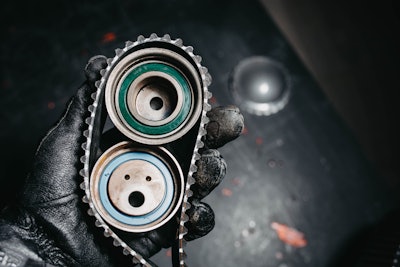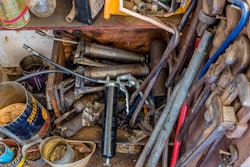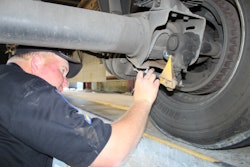
The following was published in CCJ's Equipment Maintenance Toolkit, 8th edition, sponsored by Valvoline Heavy Duty. CCJ's Equipment Maintenance Toolkit is a complementary industry resource, courtesy of our partnership with Valvoline Heavy Duty. You can download the entire Toolkit here.
Rubber ages with heat and flex, and engine belts are put through paces featuring copious amounts of both.
According to 2018 industry data, accessory drive belts were replaced at a rate of 1.58% of vehicles and timing belts on just 1.26%. In both cases, those rates have declined over the past five years, driven by the improved quality of the belts themselves, said Tom Lee, marketing manager for Continental Contitech.
Modern belts are made out of ethylene propylene diene monomer (EPDM), which seldom shows visible signs of wear, said Homer Hogg, director of technical service for TravelCenters of America.
“Looking for cracks and splits is not very helpful,” Hogg said. “Technicians must use a belt wear gauge tool as one of the steps toward identifying a belt that needs to be replaced. Others symptoms may include an alternator that is not charging properly, a noisy belt drive system and/or poor A/C performance.”
Jon Salter, director of shop operations for Pilot Flying J Truck Care said a belt tension gauge, which allows a technician to test for proper tension on a belt, can also indicate the wrong size belt installed or a weak or worn tensioner pulley.
Absent visible cues that a belt is nearing its end of life, mileage can be a key indicator. Hogg recommended a miles-to-replacement window from 100,000 up to 300,000 miles depending on the belt’s quality and the truck’s duty cycle.
“If a vehicle is running in a severe-duty application, the belt may only run 100,000 miles,” he said. “An over-the-road application with a top-quality belt can go 300,000.”
Lee suggested monitoring accessory drive belts at around the 60,000-mile mark, noting that the vehicle manufacturer has guidelines reported in the owner’s manual and recommended maintenance guide for the timing belt.
Beyond basic recommended intervals, the failure of belt drive components also presents a prime opportunity for a belt change, Lee said.
“If for some reason the water pump or an alternator must be replaced, the belt should be replaced as well,” Lee said. “If replacement or repair is required on any of these major components, it’s a good indication that the belt or hose is nearing the end of its useful life.”
The belt drive consists of not only a rubber drive belt but also a tensioner, idlers and maybe an alternator decoupler. Lee said tensioners and idlers have bearings that also can fail, which in some cases also will cause the belt to fail.
“A preventative inspection should not only cover the belt or hose but should also cover the related components,” he said.
Noise is often an indication of a loose, worn or misaligned belt. Hogg warned against belt lubricants and conditioners that are designed to simply stop the squealing.
“If a belt is noisy, the source of the problem must be determined and corrected,” he said. “Adding chemicals to a belt can cause the belt to pick up small pebbles and dirt, which will shorten the life of the belt and can damage other belt drive components like pulleys and tensioners.”
Spraying clean water on the belt can help identify if the problem is with the belt or a belt drive component. If the noise gets louder, it is likely a belt — or at least belt slippage, Hogg said. If the noise goes away, it is likely a chirp due to a potentially misaligned pulley or tensioner.
“Be careful when spraying the belt with water while the engine is running,” he said. “Loose clothing and/or a hand or finger can get caught in the belt drive system and can cause severe injury.”











